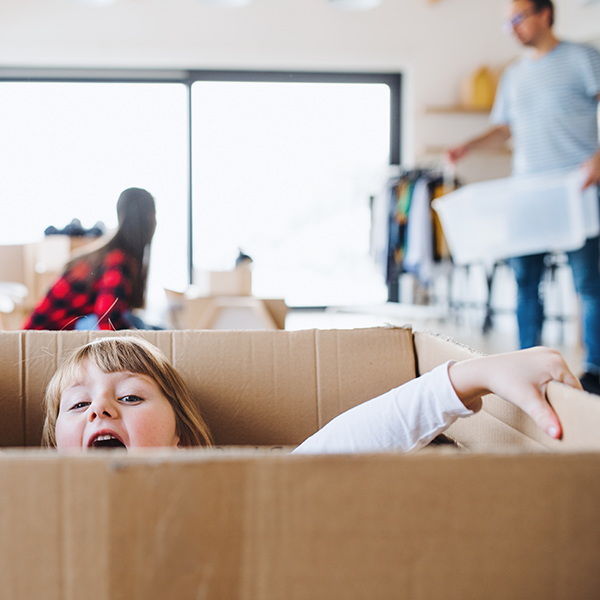Tips for Packing to Move
Tips for Packing to Move
Make Your Transition From Home to Home Easier

There’s no way to sugarcoat it: moving to a new home, although exciting, takes a lot of work and can be stressful.
But there are steps you can take to make your relocation go more smoothly. We’ve compiled a list of tips for packing to move that you should consider before you break out the boxes and rent a truck.
Moving into a new home or condo? Protect it with insurance from AAA.
Tips for packing to move
- Plan ahead. Give yourself plenty of time. Start planning for your move up to six weeks before you intend to leave your current home. This will ensure that moving day is less of a hassle, regardless of whether you are using a moving company or doing it yourself.
- Make an inventory list. Keep a tally of the number of boxes you’re taking with you on a sheet of paper. That way, you can be sure you have the same number when you get to your destination. This is especially important if you are using movers.
- Keep or discard. Figure out ahead of time which items you plan on taking with you and separate the items you intend to get rid of or put into storage. Check storage space before you move to be sure there is enough room for additional items.
- Collect supplies. Before packing to move, try to estimate how many boxes you’ll need to pack all of your belongings. Make sure to collect a number of boxes of various sizes. You can purchase moving or packing kits online from moving companies.
- Other items to have on hand. Unprinted news wrap, bubble wrap, permanent marker, packing tape, labels, box cutter and mattress covers.
- Pack nonessentials first. Anything you can do without for the time being should be packed first. This includes winter or summer clothing, depending on the season when you move, or sports gear.
- Label boxes. You’ll thank yourself later. It will make your life a whole lot easier when it comes time to unpack if you have some idea as to which items are included in each box. Label the tops and sides of each box and, perhaps, write the room of your new home where the contents of a particular box will go. If you are using movers, be sure to write “fragile” on any boxes that apply.
- Limit box weight. If the boxes you’ve packed for your move are too heavy, you risk injury to yourself and damage to your belongings. Ideally, a box should not be heavier than 50 pounds. Also, be sure to place the heaviest items in any given box at the bottom.
- Protect fragile items. It’s a good idea to pack towels, linens, clothing or pillows into boxes containing fragile items to prevent them from getting banged up or broken. Another safe option is to purchase bubble wrap, which is inexpensive and keeps dishes from bumping into one other.
- Keep important records with you. These could include your birth certificate, Social Security card, passport, tax documents, checkbooks, original copies of wills, drivers licenses and any investment papers. Don’t pack these items into boxes, but keep them in a safe place where you won’t lose them.
- Packing clothes. Use either suitcases or heavy garbage bags for your clothing. Standard garbage bags will likely rip from the weight. Use garbage bags sparingly if you are hiring movers as many companies prefer them not to be used.
- Moving furniture. If you are disassembling a piece of furniture, keep all parts (including screws, bolts and other small pieces) together, so that there is no confusion when you reassemble it in your new home. If you are moving a table, unscrew the legs and when carrying a desk, take out the drawers first. Wrap protective padding around scratchable furniture, such as table tops, coffee tables or headboards. Padding can be rented from moving companies or storage facilities.
More tips for packing to move: Packing the truck
- Group similar boxes together before you begin packing to move.
- Move the largest and heaviest items first, such as the stove, washing machine, refrigerator and dishwater. Be sure you have several people to help you carry these items. Place the heaviest objects on either side of the truck to achieve balance and keep all items in an upright position.
- Use furniture padding to protect the surfaces of your belongings.
- Place longer items such as box springs, mattresses, mirrors, headboards, couches and tables against the longest walls of the truck.
- After the largest and longest items, put in the largest and heaviest boxes. Fill as many of the crevices in the truck as you can, so that items don’t slide while you are driving.
- Next, transfer lighter boxes to the truck and stack them on top of the heavier ones.
- Place fragile items in the truck last and in such a way that they will not move during transport.
- Use soft objects such as bags of clothes, blankets, towels and linens to place between boxes or furniture to prevent them from moving around during transport.
AAA offers discounts to help you save on your move, including savings of up to 12 percent on Penske truck rentals when booking online.